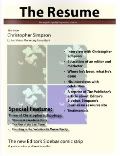Jingles that jangle, jingles that sing
The following is a reprint of the Ad Nauseam column which appeared in the August 26, 2008 edition of the Metaverse Messenger
“If you’ve got something to say,” David Ogilvy once advised, “then say it. If not, sing it.”
Okay, so the great advertising guru wasn’t what you’d call a “fan” of the jingle, but that doesn’t mean they don’t have their place. As we noted last week, jingles have been a staple form of marketing since Wheaties’ first aired theirs in 1929.
Still, Ogilvy’s got a point. “I do not regard advertising as entertainment or an art form,” he said, “but as a medium of information.” If you consider your marketing strategy to be a means of providing prospects with pertinent information about your product, then song is definitely not the way to go. On the other hand, once you’ve provided the information, there’s nothing wrong with a little mnemonic to help them remember, and music is one of the best mnemonics in existence. At the age of five I could spell “encyclopedia” (albeit the American spelling) thanks to the Jiminy Cricket song, and who didn’t learn their alphabet to the tune of “Twinkle, Twinkle Little Star”? Even dance steps can be imparted through the use of a catchy tune, such as “The Hokey Pokey” (which also taught us that “that’s what it’s all about”).
But while jingles are widely used on radio and TV, they’re still a relative rarity when it comes to the Web — and even more of a rarity in the virtual world.
There’s really little reason for this neglect. With faster connections, more powerful computers, and an increasing use of the Internet for watching everything from television shows to YouTube videos of professors having a meltdown over cell phones, sound has become an integral part of the Web experience.
For the Second Life merchant I would make two recommendations. First, combine your store or product with a web site. Although residents generally search for merchandise in world, there is increasing web traffic having to do with virtual worlds in general, and Second Life in particular, and a web site gives you the opportunity to fulfill Ogilvy’s prime directive of giving the prospect information. Second, create or buy a jingle and use it judiciously both in world and on the web site.
The last thing you want is to overburden visitors with a repetitious, annoying jingle. (Well, okay, the last thing you want is for Earth to be struck by a killer asteroid, but that’s a different matter.) One way to avoid this (the annoying jingle, not the killer asteroid) is to insert it into your music stream at regular intervals matching those of television or radio commercials.
Another way is to use a jingle that isn’t so annoying it makes your visitors want to see Earth struck by a killer asteroid.
If you have a band, or know someone with a band, you can experiment with creating your own jingle. Be very cautious, however. It’s one thing to ask a buddy to whip up a short tune for you; it’s another thing to tell him you’re not using it because it sucks worse than the last season of Happy Days.
Another option is to actually pay for it. Admittedly, there are sites out there which will provide jingles for free. One of them, The Jingle Generator, is an automated program in which famed ‘70s record producer, Tommy Silk, puts together a jingle you can download on the spot. Tommy Silk, of course, was responsible for innumerable gold records, and when I say “innumerable” I mean that literally, since there’s no way to actually count to zero. A fictional character, Tommy’s jingles are all identical except for the lyrics which change according to the type of business you select. The site itself is really nothing more than a promotion for Intuit’s QuickBooks accounting programs.
On a more serious note, however, a growing number of services are ready and willing to create web jingles for reasonable prices. Internet-jingles is dedicated to “adding sound to sound websites,” Web Jingles promises “Your sound, their senses,” and Premiere Jingle Service promotes jingles “Because Nobody Hums a Newspaper Ad.”
One of the more notable among these is Sound Strokes Studios (“Talent worth knowing”) which has been in the jingle-writing business for 20 years, the last ten of which have included web jingles. With clients like IBM and Apple, they’re unquestionably major players in the field. The husband and wife team of Cory and Andrew Paganini is uniquely suited to putting the right words to the right music since Cory’s father is a newspaper man while Andrew is a direct descendant of violin virtuoso Paganini.
“I always start with a strong slogan,” says Cory Paganini, who writes the lyrics which Andrew then puts to music. For one of their clients, Canadian Free Stuff, she used the tagline, “No need to travel.” Set to a light Latin beat, the message that you can get free stuff while sitting at home in front of your computer is pleasantly, and memorably conveyed.
Regardless of whether you create it yourself or hire a professional, a good jingle will help keep your product or service in the minds of your customers. But don’t cheat. “Some of the people on radio stations have used our jingles and cut them short, putting in their own call letters,” said Cory.
That’s just not nice.
Read more...






